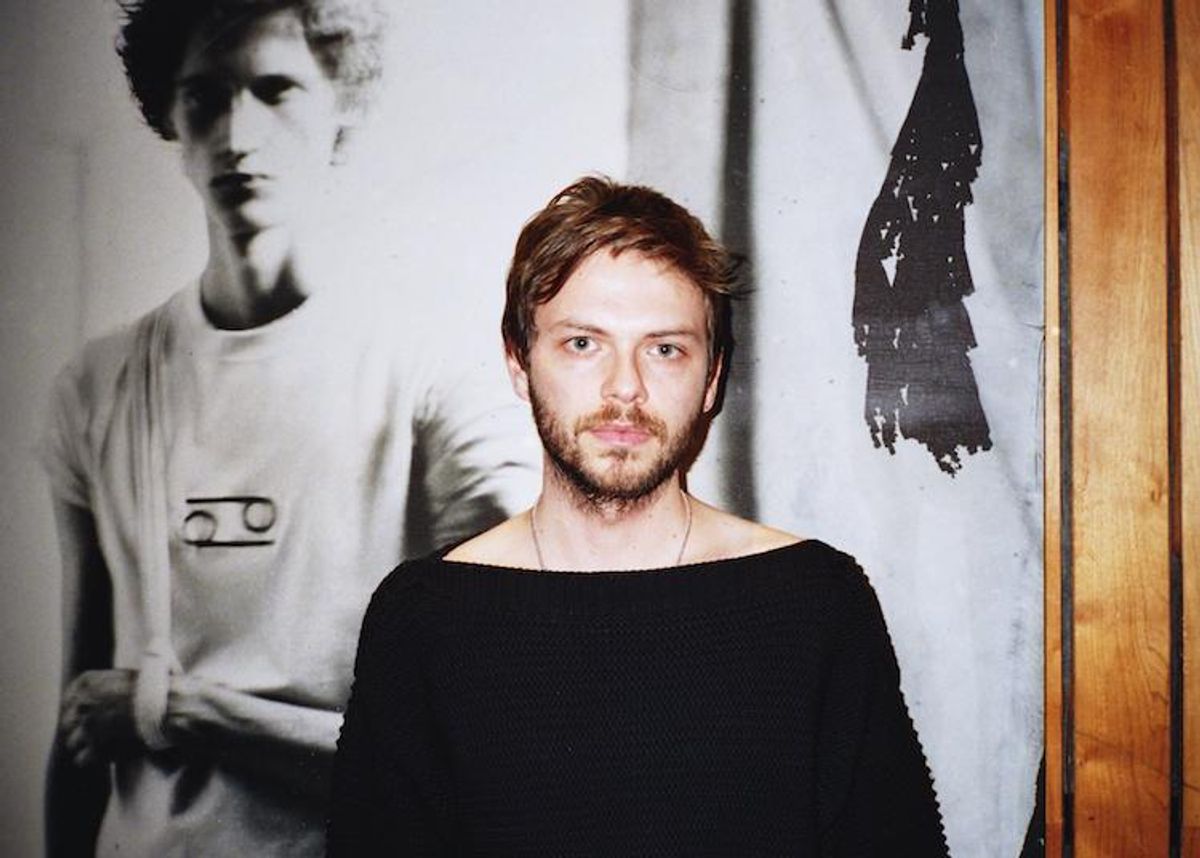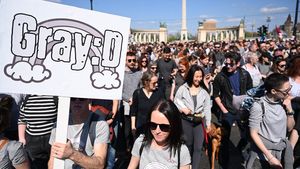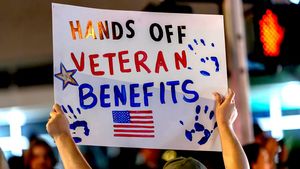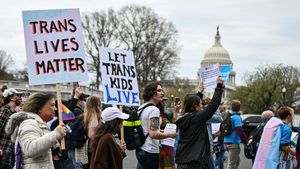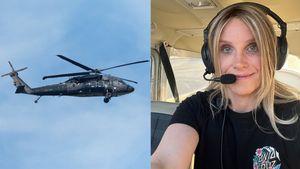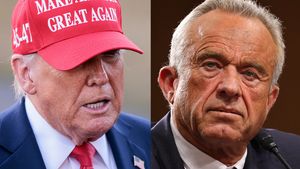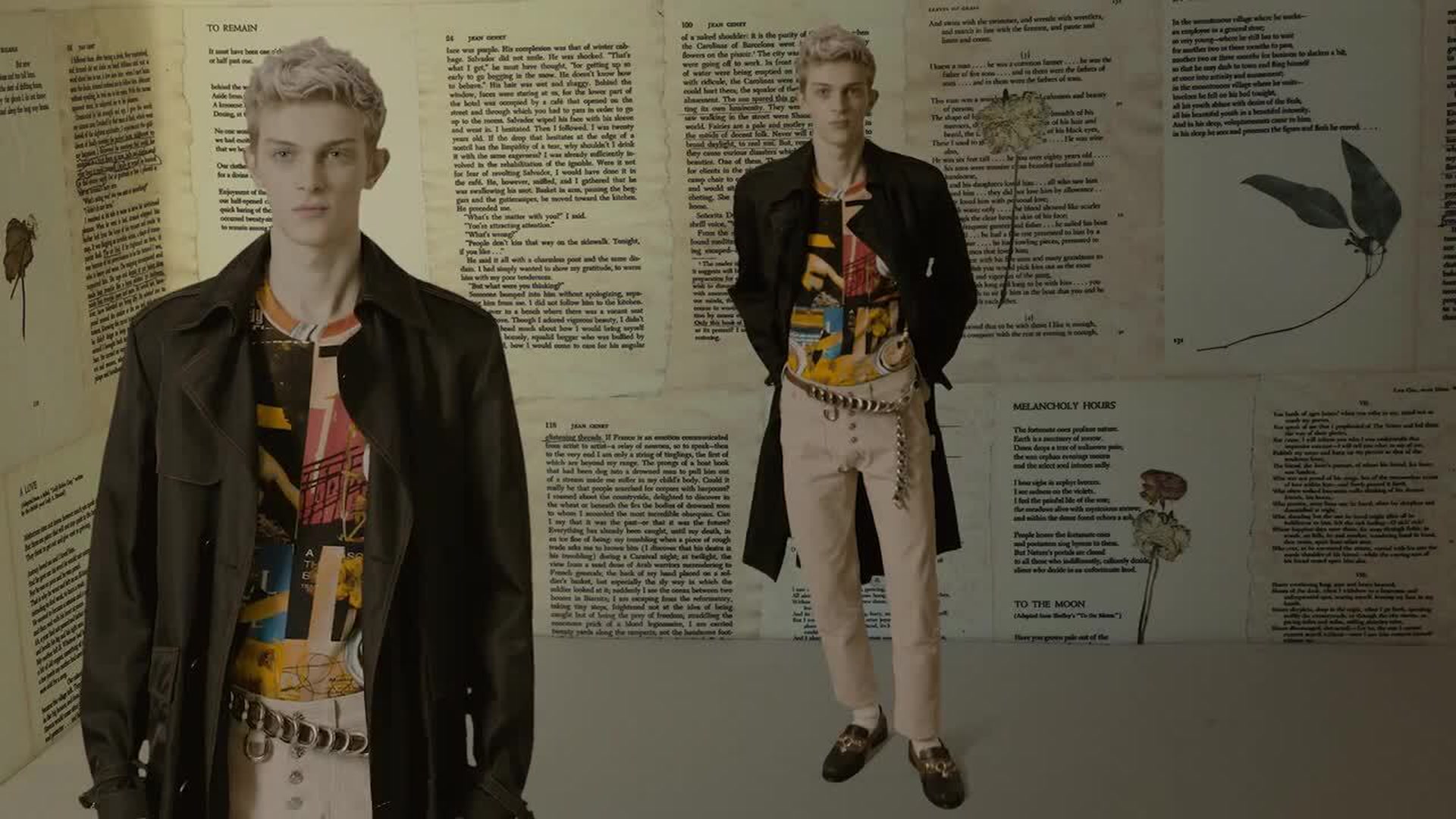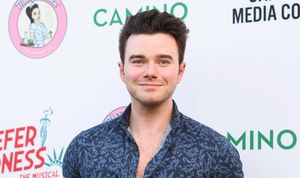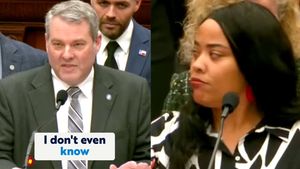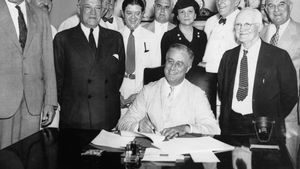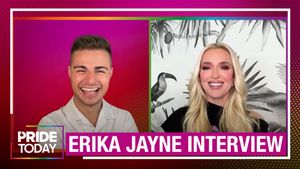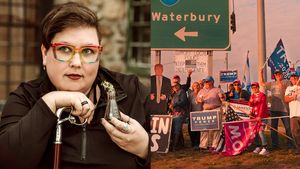While some designers punctuated their collections with bombastic UFOs or soul-shaking hypebeast conventions, Linder designer Kirk Millar set up a military tent in the wood-paneled walls of The Standard High Line for an intimate return to his roots as he crafted a collection around his experience coming out years ago.
Related | Linder's Sensitive, Sensual Ode to Queer Literature
It was a natural starting point for the young designer. As he and Sam Linder made the decision to split the brand's menswear and womenswear collection moving forward, Millar began to build up a world steeped in the tender period of coming out as a 20-year-old college student. Much to the horror of bibliophiles, he turned to the pages of the queer authors he forged an intimate bond with in that seminal period of his life and ripped them out of his own personal books.
With the pages in hand, he intertwined them in masculine, militant silhouettes as he queered and softened the ideas of heteromasculine conformity that so often plague the gay community. As he explained in his show notes, "FW18 examines the pressure young homosexual men feel to fit within the culture's idea of what makes a man, i.e. toughness, aggression, physical strength."
Throughout his solo menswear debut, he created garments superimposed with the words of Walt Whitman and Constantine Cavafy; crafted a military watch out of a Vaseline jar in reference to John Genet's A Thief's Journal; and adorned the clothes and jewelry with the traditional male symbol "as a display of the romantic love for other men--as a badge to wear proudly."

With queer literary and militaristic masculine influences stitched into the seams of the collection, Millar set to work on creating a world for his emotionally tender collection to exist within. He created an early lookbook to preview the collection that accessorized the garments with his own collection of books; teamed with Driely Carter for an astrologic calendar featuring photos of bandaged and battered boys in military tents to symbolize a "fantasy landscape of emotional sensitivity represented as the external wounds of soldiers;" and created a 62-track playlist with music from '60s gay folk singers, '50s love songs, and selections from the Call Me by Your Name and Brokeback Mountain soundtracks.
Under his sensitive, all-encompassing care, Millar took Linder's FW 18 Menswear Collection and turned it into one of New York Fashion Week's most unforgettable shows. While he settled into the post-show glow and started to conceive his next collection, we caught up with the designer to talk about Vaseline jars, crying to Call Me by Your Name, and the importance of finding someone "who loves seeing you wearing exactly what you love wearing and being exactly who you are."
OUT: Walk me through the decision to have the preview lookbook come out at Paris Fashion Week ahead of the presentation during New York Fashion Week.
Kirk Millar: As Sam Linder and I split off between men's and women's collections, I think we just wanted to get it out there and then do something more personal for the presentation. With the lookbook, I felt a lot of conviction behind that.
Masculinity is so pervasive in our culture and I like that, with this collection, it takes masculine silhouettes and makes them distinctly feminine. How do you interact with these feelings of masculinity and femininity in your own life?
Throughout the time that I've lived here, one thing I really liked getting to a place of was taking care of this traditionally feminine side of myself and embracing it. I usually do it in a slightly subtler way, but I think New York is the type of place where you can be whoever you want to be and find other people who are interested in the same things as you.
I was talking to a friend of mine who said that they should dress more "butch" to get a boyfriend. Those kinds of remarks are damaging. You will find somebody who loves seeing you wearing exactly what you love wearing and being exactly who you are. That kind of sentiment... I feel really emotional about that because everyone wants to feel appreciated for who they are. That is what I love about people being able to wear whatever they want and identify however they want. That's the last place you need to feel like you're compromising who you are in fundamental ways.

How'd you come up with the concept behind having the models interacting with books in the lookbook?
It flowed from the elements that went into the collection. I wanted to feature books that I had torn the pages out of or had been reading and pulling from. The dried flowers started when I had been pressing flowers someone had given me. It was a continuation for me of the collection.
For the casting, I wanted to have almost emotional avatars for that kind of moment in your life as a gay man when you come out. It's a very tender time or at least it was for me. I think it is for many people--the first experiences and the bravery and all of that. I wanted the guys [in the lookbook] to feel somewhat introverted and for there to be a sensitivity because that's how I felt during the development of the collection--I was revisiting those years of discovery I had.
How old were you when you first came out?
I was 20-years-old.
Was it in college?
Yeah, it wasn't really a choice of mine. Someone outed me so it was a bit of a different scenario but I don't think it's that uncommon. It's fine and its part of my own story, but it led me to move here quickly after it happened and I've been here ever since. I obviously don't regret that happening.
For the first collection that I designed without Sam and I working together, this was a very specific idea and feeling for me. Coming out was a pretty pivotal moment in my life--and I know it is for many other gay men--so that felt like a genuine place to start.
At The Standard, you had a mix of songs playing throughout the presentation. How'd you pick the music to set the mood and what kind of songs made it onto the playlist?
The playlist was created for the presentation, but many of the songs we listened to a lot during designing. There are film soundtrack songs from Brokeback Mountain and Call Me By Your Name. Brokeback Mountain I watched right when I was discovering my first encounter with a guy, and I only recently saw Call Me By Your Name right after the collections release in Paris. They both had an incredible impact on me emotionally and I felt they were good cinematic bookends to a collection that was really a long time coming.
There are quite a few songs by an openly gay musician Peter Grudzien, who wrote folk songs in the 60s in Greenwich Village. I also included a few songs from the 1950s that are all about heartbreak--they added a kind of candy version of emotional desire that I wanted to convey. There is something so tragic about those particular songs' tones versus the lyrics.
With this being your first collection that you have full creative control over, it makes sense that this would be the most personal one for you.
Absolutely. Even with the books, those were books I've had since I moved here. I ripped those pages out of my personal books. It was a turning point in a certain way for me, I think.
With that personal connection to these books, how does it feel to see the collection finished and see the garments with the pages superimposed onto them?
(Laughs) It feels good. It's one of those things that's almost so personal that at first, you almost grimace and worry that you got too personal. It's something that I feel a lot of people can relate to and it almost speaks on behalf of a larger conversation.
Definitely. We do have a shared story of coming out and dealing with these emotions. It's nice to see these classic authors like Hart Crane and Walt Whitman in the collection because there's this weird trend I've seen where people don't read much anymore and often pride themselves on not reading so much anymore.
It is odd. With social media and this obsession with self-image and actual photography, I don't think most people are reading or interested in spending the time to escape into a world that is not visual, frankly. Maybe that was also a starting point for incorporating books. I feel an intimacy in reading these books.

In the collection, you reference John Genet's Vaseline jar story. What struck you about that?
In The Thief's Journal, as he describes it, that experience is humiliating because of being stared at and having one thing that, to the rest of the world, is very abject and gross. He looks at that Vaseline jar as a refuge in a way. He puts it on a pedestal and worships it because it's something he can't separate himself from. That was such a meaningful part of the book because it's an acceptance of not just being gay, but realizing there is no ability to deny. Instead of feeling ashamed, he turns it into a strength. That's a striking moment.
You turned that Vaseline jar motif into a military response, right? Was there a reason to make it a military watch specifically?
The military aesthetic was all about the pressure to be masculine. The military is a very stereotypical, masculine environment. You really have no choice. Once you're in it, you're doing whatever is told to you and that's a bit similar to our culture. Men in general--gay or not--have a pressure to be masculine. That's a pressure that can be very damaging and so many guys I know have dealt with balancing that and coming to terms with their more traditionally feminine side.
I don't think the Vaseline jar was on a watch for a specific reason. It's more surrealist as opposed to connecting the point of the jar in the book with time, for instance.
Do you seek out gay and queer authors or is that who you find yourself drawn to?
Yeah, for a long time, I found refuge in that relatability so I did seek them out to understand more about myself. Maybe that's why this collection is specifically about books for me. I have had that intimacy with them and I realized that I've read a lot of books that--whether or not they're by a gay author--are about gay romance. Even thinking about how many movies or books there are that aren't about that, I think it's nice to have that niche.
That's why Call Me by Your Name is such a big deal for people. There aren't many well-done, big-budget gay movies. It's clear to me that that's something that is necessary and something people want. I read the book a few years ago and I don't remember the book being something that I was captivated by. I did think the movie was really well done and was really sensitive.

How much did you cry?
Oh my god. So much. I was there with a friend and he was like, 'I did not know what to do with you.' It took me quite a while to get back to a normal state. It was beautiful but extremely intense. As gay men, we don't have a lot of romantic stories and that one is a very traditional romantic story. I think that's clearly something that is important.
Speaking more of the political climate. Do you feel that what's happening in the world has impacted your collection?
I think that this environment does make creative people want to say more. I think that's something that yields results in a certain way and more people have something to say right now, which I think is a good thing.
Photography: Cameron Lee Phan
